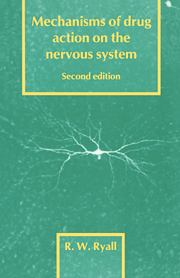Preface to the second edition
Published online by Cambridge University Press: 08 October 2009
Summary
Since the first edition of this book was published in 1979 there have been some major advances in all areas of knowledge concerning the physiology and pharmacology of the nervous system, although some advances are much greater than others. Each of these advances can on the whole be attributed to advances in technology. New technology for the measurement of receptor binding and immunological techniques, combined with the production of monoclonal antibodies, have been responsible for the greatly increased understanding and apparent complexity of receptors and their ligands. Only recently have some notes of caution been raised concerning the interpretation of ligand binding data as necessarily reflecting the properties of receptors. Advances in electrophysiological techniques now permit not only noise analysis of single channel events but also direct recording of the electrical currents flowing through those channels: I refer of course to single channel current recording with ‘patch-clamp’ techniques and the use of modern, high frequency, voltage-clamp amplifiers. Considerations of space in a book of this size and scope does not allow more than a brief mention of the technology. Finally, the age of the computer has brought with it considerable benefits, together with some consequential difficulties. Among the benefits is the ability to analyse complex events or to build up complex pictures of three dimensional objects which was not possible in an earlier generation. Complex experiments are now easier to perform than ever before. Among the potential hazards is the proliferation of trivial data which are impediments rather than aids to understanding.
- Type
- Chapter
- Information
- Mechanisms of Drug Action on the Nervous System , pp. xiii - xviPublisher: Cambridge University PressPrint publication year: 1989

